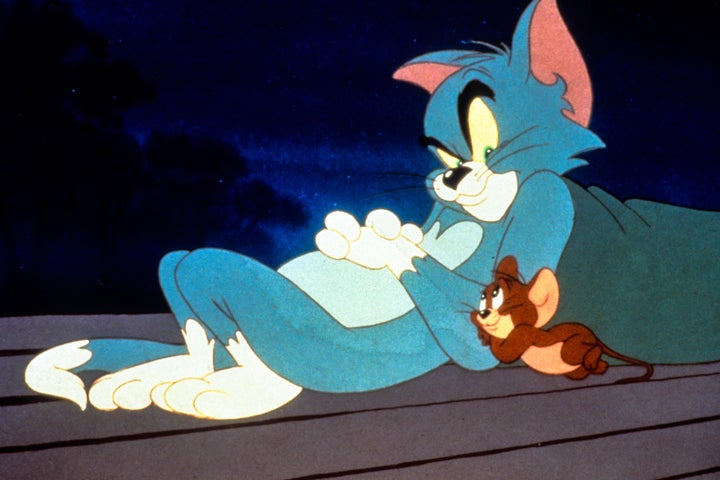
On Wednesday, the CIA released a dump of declassified documents and computer files recovered from Osama bin Laden’s Abbottabad, Pakistan, compound during the 2011 Navy SEAL raid that killed him. In this huge digital trove, amid stuff any reasonable observer might find somewhat surprising and counterintuitive in the possession of a fugitive radical terrorism financier ― screencaps from pornographic video games, a viral YouTube video of a British baby biting his brother’s finger, anime ― are 138 files that make perfect, dismal sense: “Tom and Jerry” cartoons. Bin Laden, if the contents of these files are to be trusted, was very possibly a nut for “Tom and Jerry,” and literally nothing in the history of the world has ever made more sense than that.
The way a joke works is, it starts with a buildup of expectations, and then, if the joke-maker does a good job, it defies those expectations in a surprising way, revealing something absurd about both the expectations and the reality that defied them. What’s funny, in the best jokes, is the glimpse you get of a silliness that reaches beyond the joke itself, to goose you for the universal condition of having an intellect in a world that will always find ways to exceed it. What’s funny in “Tom and Jerry” cartoons is: nothing. They are objects of dull, nihilistic cruelty fetishism for sociopaths.
For fun and tribal warfare, I like to compare (sometimes at frankly insane length) “Tom and Jerry” to the Road Runner and Wile E. Coyote cartoons created for Warner Bros. by the legendary animator Chuck Jones and his writing partner, Michael Maltese. The latter were conceived, initially, as a spoof of the former, and they provide an instructive contrast.
In the Road Runner and Wile E. Coyote cartoons, the famished coyote schemes up ever more absurd methods for hunting the unflappable Road Runner across the barren, endless desert, and is foiled, again and again ― not by the Road Runner, but by his own ineptitude, then by the catastrophic failure of mail-order products, and then by the laws of the physical universe itself, which warp and contort themselves to ensure he will never succeed. The structure of a Road Runner and Wile E. Coyote cartoon is: The coyote’s schemes respond to and comment on each other, rhythmically and thematically, revealing the coyote’s doomed ambition and hubris and desperation. So do their results, pointedly returning again and again to the bird’s-eye image of him plunging to the bottom of a ravine, no matter what he does. The joke is about failure as an essential and inescapable part of having an intellect, and also, maybe, I hope, about postwar American helplessness to remedy our needs except via the products of unaccountable far-off corporations selling shoddy crap.
But the point, here, is that there is a joke. There is at least one insightful existentialist joke in Road Runner and Wile E. Coyote cartoons. They are about something. There is no joke in “Tom and Jerry.” To the extent the cartoons are about anything, their theme is, “It’s great when awful, painful, violent stuff happens to someone else.”
Whereas Wile E. Coyote is a gaunt, starving wretch in a desolate wasteland, forced by hunger and circumstance to chase the only prey animal ever shown, Tom, the cat, is a plump, apple-cheeked pet in what typically appears to be a large, well-kept home. He has no particular motivation for pursuing Jerry, the mouse, except the reflexive impulse to prey upon and destroy something smaller than himself ― and then, after Jerry has foiled him, a sense of vengeful, reactionary grievance. Jerry, for his part, is a revoltingly cutesy psychopath; much of the time it’s made clear that he is not content merely to escape Tom, but relishes punishing him via sadistic methods that cause Tom excruciating pain and terror. Often he goes out of his way to prompt Tom’s attacks. Unlike the Road Runner, Jerry is not going somewhere else ― he has no business except provoking Tom so that he can hurt him. Essentially, he is the villain of the ”Saw” movies, but for little kids.
Structurally, “Tom and Jerry” cartoons are the opposite of Road Runner and Wile E. Coyote cartoons. The chase sequences connecting Tom’s defeats are rote and meaningless and reveal nothing in particular about either Tom or Jerry. The variety, the point, is the awful, painful, violent stuff that happens to Tom at the end of each sequence, which does not happen for any particular reason except that the viewer is expected to enjoy watching it.
Why is any of it happening? What motivates either of these characters? “Tom and Jerry” is not interested in such matters. There is only Tom’s desire to do horrible violence to Jerry, and Jerry’s delight in doing horrible violence to Tom. What’s worse than the idea that viewers will relate to this and recognize themselves in it is the possibility that they will not, but will enjoy the carnage anyway, because it is not happening to them but is happening to someone else.
The world is a simple and purposeless machine whose only inputs and outputs are war. As a theory of things, this has much to recommend it for anyone who has lived through basically any part of human history. What’s chilling is the idea that anyone would enjoy watching this theory enacted, on screen, by a cute animated cat and mouse, in a cartoon for little children. Well, anyone other than a maniac whose life’s work was fear and death, I suppose. What’s your excuse?
Albert Burneko writes for Deadspin.